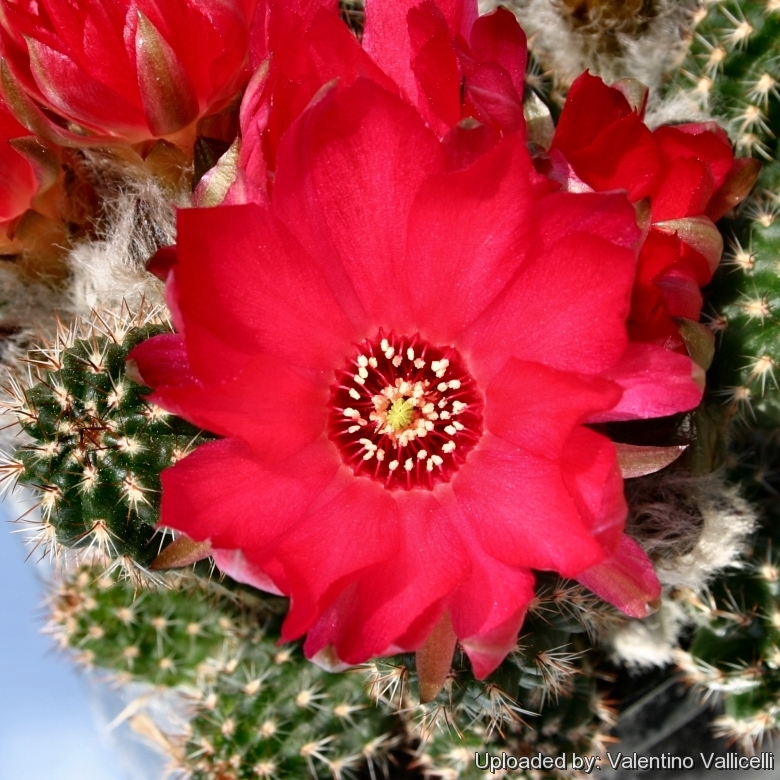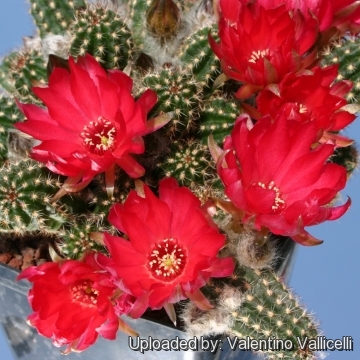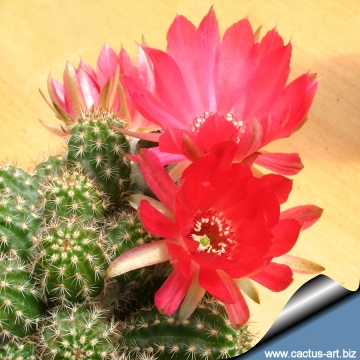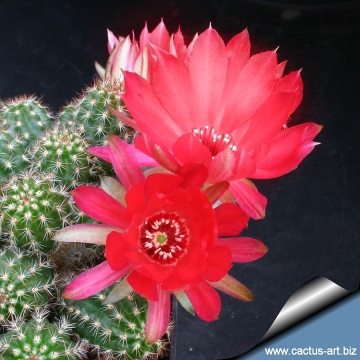Accepted Scientific Name: Echinopsis chamaecereus cv. Rot Violet
Chamaelobivia hybid

х Chamaelobivia cv. Rot Violet (Echinopsis chamaecereus cv. Rot Violet) Photo by: Valentino Vallicelli
Origin and Habitat: Garden origin (Nursery produced cultivar) Hybrid Chamaecereus sylvestris x Lobivia sp.
Synonyms:
Description: The Chamaelobivia hybrids. Chamaecereus silvestriiSN|8694]]SN|8694]] (now renamed Echinopsis chamaecereus) is an old species widely hybridized with various Lobivias, hence Chamaelobivia (intergenic hybrid of Chamaecereus and Lobivia), but since both of those are now reclassified as Echinopsis, that makes this an Echinopsis hybrid.
Chamaelobivia are very popular hybrids that develop really amazing flowers of different colours on the original "peanut" body and many of these hybrids have cultivar names. This plants soon form spectacular clumps with 20-30 (or more) flowers at a time, and are quite a sight. They are often thicker, stronger, larger-growing than C. sylvestrii, and tend not to have the typical peanut shaped offsets. The offsets produced are more strongly attached to the main stems.
Most of these hybrids can grow outside all year and can take a lot of sun. Hardy from -4° to -12° C, depending on clone.
Subspecies, varieties, forms and cultivars of plants belonging to the Echinopsis hybrid (Chamaelobivia) group
 х Chamaelobivia cv. Rot Violet (Echinopsis chamaecereus cv. Rot Violet) Photo by: Valentino Vallicelli
х Chamaelobivia cv. Rot Violet (Echinopsis chamaecereus cv. Rot Violet) Photo by: Valentino Vallicelli х Chamaelobivia cv. Rot Violet (Echinopsis chamaecereus cv. Rot Violet) Photo by: Cactus Art
х Chamaelobivia cv. Rot Violet (Echinopsis chamaecereus cv. Rot Violet) Photo by: Cactus Art х Chamaelobivia cv. Rot Violet (Echinopsis chamaecereus cv. Rot Violet) Photo by: Cactus Art
х Chamaelobivia cv. Rot Violet (Echinopsis chamaecereus cv. Rot Violet) Photo by: Cactus ArtSend a photo of this plant.The gallery now contains thousands of pictures, however it is possible to do even more. We are, of course, seeking photos of species not yet shown in the gallery but not only that, we are also looking for better pictures than those already present.
Read More... Cultivation and Propagation: The Chamaelobiva hybrids are very easy to grow, and are the ideal plants for beginners. The parents of all Chamelobivia come from mountainous areas, so they like bright light, cool and dry conditions in the winter. The whole Chamelobivia complex has delightful flowers and the plants remain compact, and clumps can easily be managed by division. They flower freely indoors if conditions suit them.
Growth rate: Chamaelobivia is a relatively fast growing and easily flowering species that will make large clumps given the best conditions.
Soils: This species is without problems in a very open mineral mix with at least 50% sand or pumice grit and a pH slightly on the acidic side.
Repotting: They will occupy a small pot comfortably, and eventually remain a manageable sized house plant. It is better that they are repotted regularly. Repotting will increase the number and size of stems, and will increase the number of flowers produced. Repot yearly until they reach about 100 mm in size, then every two or three years will suffice. Repotting is best done at the end of winter, but can be done at other times, too. Do not water for a couple of weeks after repotting, to reduce risk of root rot via broken roots. A layer of 'pea' gravel at the bottom of the pot improves drainage. A layer of decorative gravel as a top dressing helps prevent the caking of the potting mix, which decreases the rate of water absorption. It also keeps the perlite and pumice from blowing everywhere, and looks nice.
Watering: It requires full sun or light shade and careful watering to keep plant compact, and maintain strong and dense spines and allow the pot to dry out between waterings. Keep dry in winter at a minimum temperature of 0°C. Rebutia albipilosaSN|4948]]SN|4948]] tends to rot if too wet. The plants can be placed outdoors in April, but protected from rain and direct sunlight. Water them thoroughly when placed out, and again in two weeks, and again in one week. After one month the plants are ready to be placed out in full sun and full rain for the summer. During dry spells the collection is watered once a week, during hot dry spells, twice a week.
Fertilization: Feed with a high potassium fertilizer in summer.
Hardiness: It is reputedly resistant to frost if kept on the dry side prior to, and during, cold weather and requires a winter rest period (hardy to -7° C, or less for short periods). They grow in nature at high altitudes, and do not thrive well at high temperatures in cultivation. They will often go dormant in mid-summer, and resume growth again when the weather cools in late August. They can tolerate amazingly low temperatures for long periods of time. All species can take light frost, even when not bone dry. It is generally accepted that plants kept at too high a temperature, or watered too much during the winter rest period, will not bloom the following year. They will be perfectly happy in pots outdoors from April to September if protected from torrential rain and hail. However some warmth throughout the year will increase the grower's success (minimum 3° C during rest season).
Exposition: The plant tolerates extremely bright situations but enjoys filtered sunlight or afternoon shade, inside it needs bright light, and some direct sun. Tends to bronze in strong light, which encourages flowering and heavy spine production, but is likely to suffer from sun scorch or stunted growth if over exposed to direct sunlight during the hottest part of the day in summer.
Uses: It is an excellent plant for container growing. It always looks good and stays small. It look fine in a cold greenhouse and frame or outdoor in a rockery.
Pests & diseases: All, especially the young, are susceptible to red spider mites.
Rot: It is especially prone to root rot, therefore, underpot in a smaller container filled with very porous compost. However rot it is only a minor problem with cacti if the plants are watered and “aired” correctly. If they are not, fungicides won't help all that much.
Propagation: By cuttings, as it branches freely from the base. It can also be grown from seeds or by graft. Seeds can be sown in the spring or summer. The seedlings should not be disturbed until they are well rooted, after which they can be planted separately in small pots. Easy to propagate from offsets. Small joints are produced in quantities (peanuts). These offsets can be detached and planted immediately, as they root easily with no assistance when they touch the ground. Just let them lay on the soil and you have a new start.














